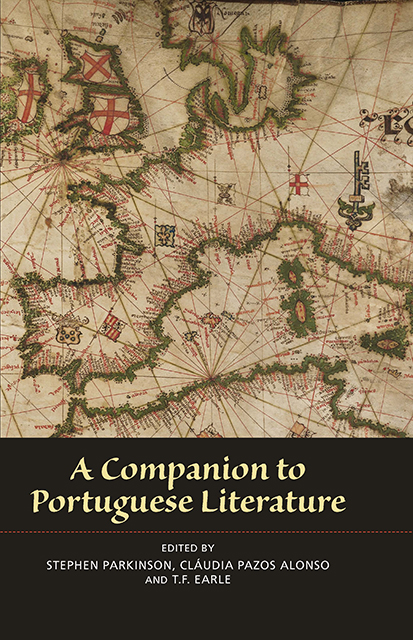Book contents
- Frontmatter
- Contents
- Acknowledgements
- Notes on the Contributors
- Introduction
- 1 Eight Centuries of Portuguese Literature: An Overview
- 2 The Medieval Galician-Portuguese Lyric
- 3 Fernão Lopes and Portuguese Prose Writing of the Middle Ages
- 4 Portuguese Theatre in the Sixteenth Century: Gil Vicente and António Ferreira
- 5 The Lusiads and the Literature of Portuguese Overseas Expansion
- 6 Lyric Poetry in the Sixteenth Century
- 7 The Seventeenth Century
- 8 The Eighteenth Century
- 9 Almeida Garrett: Founder of Modern Portuguese Literature
- 10 The Transition from Romanticism to Realism: Alexandre Herculano, Camilo Castelo Branco and Júlio Dinis
- 11 Eça de Queirós: A European Writer
- 12 Fernando Pessoa and the Modernist Generation
- 13 Narrative and Drama during the Dictatorship
- 14 Women Writers up to 1974
- 15 Writing after the Dictatorship
- 16 Portuguese Literature in English Translation
- Index
8 - The Eighteenth Century
Published online by Cambridge University Press: 03 March 2023
- Frontmatter
- Contents
- Acknowledgements
- Notes on the Contributors
- Introduction
- 1 Eight Centuries of Portuguese Literature: An Overview
- 2 The Medieval Galician-Portuguese Lyric
- 3 Fernão Lopes and Portuguese Prose Writing of the Middle Ages
- 4 Portuguese Theatre in the Sixteenth Century: Gil Vicente and António Ferreira
- 5 The Lusiads and the Literature of Portuguese Overseas Expansion
- 6 Lyric Poetry in the Sixteenth Century
- 7 The Seventeenth Century
- 8 The Eighteenth Century
- 9 Almeida Garrett: Founder of Modern Portuguese Literature
- 10 The Transition from Romanticism to Realism: Alexandre Herculano, Camilo Castelo Branco and Júlio Dinis
- 11 Eça de Queirós: A European Writer
- 12 Fernando Pessoa and the Modernist Generation
- 13 Narrative and Drama during the Dictatorship
- 14 Women Writers up to 1974
- 15 Writing after the Dictatorship
- 16 Portuguese Literature in English Translation
- Index
Summary
In the eighteenth century the Portuguese cultural field included colonies in India, Africa and Brazil. Before 1700 the country had lost a significant part of its Indian possessions, but Brazil's weight in the economy had increased since the late 1690s, when large amounts of gold and diamonds were found. Between 1700 and 1800 Portugal had four different sovereigns: João V, José, Maria I and João VI. Though each of these rulers adopted a personal style of government, the country was an absolute monarchy throughout the period. Until 1759, primary and secondary education was administrated by the Jesuits, who taught the same curriculum in all parts of the empire. As the centralized politics of the absolute state did not allow for the establishment of universities or printers outside European Portugal, anyone who wanted to have access to higher education within the Portuguese-speaking world had to go to Coimbra University, and authors willing to have their works published had to send them (or come with them) to the mainland.
As a result of this policy, most members of the cultivated elites had a common educational background, and it is impossible to distinguish the literary productions of someone born in Brazil or in any other Portuguese colony, from the works of someone born in Lisbon or Oporto. Not only had their authors read the same books, but they followed the same trends, moved in the same social circles, participated in the same networks of influence, and praised the same patrons. In this sense, one could speak of a common cultural space, where authors, texts and readers circulated under common constraints.
The strongest constraint imposed was censorship. Up to 1768 the Index of forbidden books in use was still the one published in 1624 during Spanish occupation, and the censorship system had remained unchanged since the mid-sixteenth century. It consisted of three entities: the Inquisição or Tribunal do Santo Ofício (the Inquisition), responsible for the application of the Pope's directives to the specific case of the country; the Ordinário (a council of the local bishops), controlling the works published in each diocese; and the Desembargo do Paço, or the King's Censorship, which had the right of precedence over the other two.
- Type
- Chapter
- Information
- A Companion to Portuguese Literature , pp. 103 - 108Publisher: Boydell & BrewerPrint publication year: 2009



